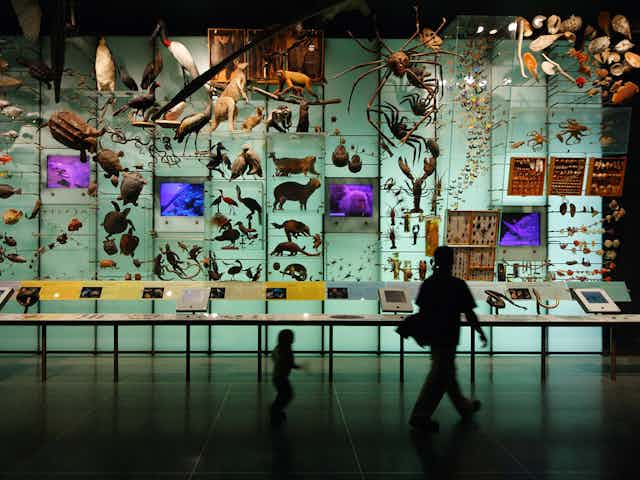The latest climate talks in Warsaw may have achieved little in the way of action on climate change, but they were even worse for biodiversity. In fact, since early climate talks in the 1990s, biodiversity has vanished from international and Australian climate policy. So, why has biodiversity become decoupled from climate change?
Biodiversity, carbon’s forgotten partner
Biodiversity is the global blind spot in climate change. Food, shelter, clean water and a climate that nurtures life are underpinned by biodiversity. It is simply not possible to avoid dangerous climate change without taking into account ecosystem services, the product of biodiversity.
Tropical forests absorb 15% of global emissions every year. Clearing them accounts for around 20% of global emissions.
All components of biodiversity – genes, species and ecosystems – are in decline. Extinction is now known to have ecosystem effects rivalling those of ozone, acidification and elevated CO2.
The problem is highlighted by deforestation.
Since 1997, about 200 million hectares of mostly rainforest have been cleared. Using conservative figures and assuming around 200 tonnes of carbon per hectare in these forests this amounts to about 147 billion tonnes of CO2. That’s equal to 245 years of Australia’s emissions at current rates. And this does not even include increases in the area of degraded forests, which is about 25% more.
The global trade in logging and felling forests grows. The trade is predicted to be worth about US$450 billion per year by 2020.
You could be excused for thinking that climate change is finally reason enough to help correct the failure of not properly valuing biodiversity. But you would be wrong.

A history of neglect
Biodiversity was front and centre at the start at the 1992 Rio Earth Summit. Secretary General of the UN Boutros Boutros-Gali opened with two minutes silence for life on Earth and an impassioned speech warning we had “only a few years or a few decades to act” on biodiversity decline and climate change.
The Convention on Biological Diversity, and the Framework Convention on Climate Change, were opened simultaneously for signature. So what went wrong?
The politics between Europe and the US collided. Europeans – fundamentally reacting to American consumerism - objected to the possibility that the United States could “buy their way out” of any real effort to reduce their energy emissions via investment in forests.
In global climate change deliberations this logic had the effect of demoting biodiversity to a mere offset. Instead of seeing the ecosystem sector working together with energy abatement - clearly the original intention - the debate deteriorated into a farce with Europeans “against” forests, and Americans “for” them.
In 1997 the role of the ecosystem sector activities (such as avoiding deforestation, forest management and agriculture) in climate mitigation was ousted from what became the Kyoto Protocol apart from narrowly defined afforestation and reforestation, resulting in a global policy discord that continues to have chaotic ramifications.

Australian inaction
Before losing the election, Kevin Rudd announced cuts to the Biodiversity Fund to help Australia transition to an emissions trading scheme. The fund, part of the Clean Energy package, rewards land managers for conserving biodiversity and reducing carbon emissions.
Less well known is that two weeks earlier another Australian carbon and biodiversity initiative was quietly shelved: the Kalimantan Forests and Climate Partnership.
Initiated under the Howard government, this ambitious project was to protect 70,000 hectares of peat forests, re-flood 200,000 hectares of dried peatland, plant 100 million trees in Central Kalimantan and lead to a reduction of 700 million tonnes of greenhouse gas emissions over a 30 year period. From 2008 the project was severely scaled back, emasculated to the point of being irrelevant, and finally simply dropped.
But worse was to come for biodiversity. The new Abbott government immediately announced the repeal of Australia’s emissions trading scheme. The government structured their new Direct Action policy around the Carbon Farming Initiative, a Labor scheme to reward land owners for reducing and storing carbon. The initiative has real potential to transform landscapes through direct action, but this rests on a high level of ambition and a high carbon price both arguably dependent on an emissions trading scheme.

What’s happening now?
Excluding forests from the Kyoto equations has added to the certain, permanent and massive loss of biodiversity without any influence whatever on American consumption patterns.
It has also effectively decoupled ecosystems and their biodiversity from climate change policy. It is possible to dismiss biodiversity, which can now be considered an after-thought (according to current Secretary General to United Nations Ban Ki-moon in the preface to the 2010 Global Biodiversity Outlook), or worse, a burden.
This is a perverse space. The European Commission, for instance, has banned forestry credits of any kind from the world’s major carbon market until at least 2020, because they are not considered real. This is despite their own report that predicts avoided deforestation measures could reduce extinctions by 86%-95% with a carbon price of US$25 per tonne CO2.
The international initiative of Reducing Emissions from Deforestation and Degradation (REDD) has also become entangled in an ideological debate about whether it is okay to use private investment to fund it. The estimated cost of reducing deforestation and degradation by 50% range is US$17-28 billion.
Since only US$4 billion per year from 2010 to 2012 has been pledged - barely a third of the lowest estimate - private finance will be essential. Keep in mind that global climate finance flows have now reached about US$364 billion, all but 5% of it driven by the private sector mostly from corporations or renewable energy project developers.
We have entered a time when good environmental outcomes no longer include biodiversity, but merely find cheaper ways for industry to reduce carbon emissions.

